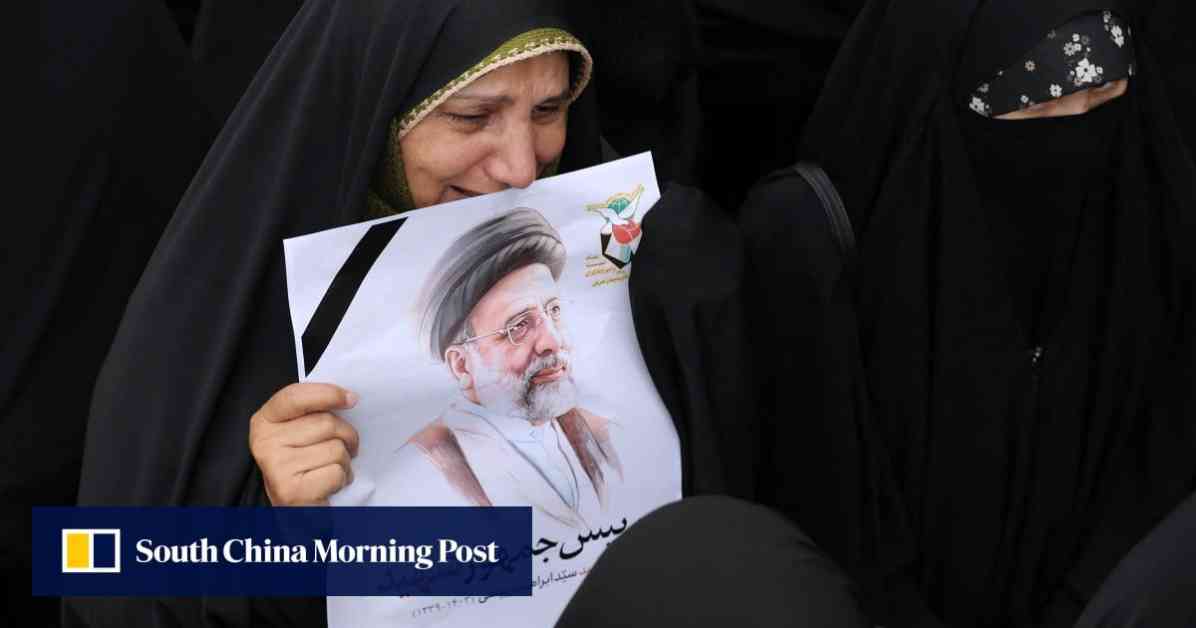Weather Conditions Blamed for Iran President’s Helicopter Crash
Iran’s late President Ebrahim Raisi met his tragic end in a helicopter crash that was attributed to bad weather conditions, particularly thick fog, according to a report released by Iran’s state television. The incident occurred in a mountainous region near the Azerbaijan border, claiming the lives of Raisi and several others on board. Raisi, known for his hardline stance and potential succession to Supreme Leader Ayatollah Ali Khamenei, was mourned by the nation following the fatal crash.
The final investigation report cited by Iran’s state television pointed to the challenging weather conditions in the region as the main cause of the helicopter crash. The high committee tasked with probing the incident highlighted the thick fog that enveloped the area, leading to the tragic collision with the mountain. Images of the wreckage at the crash site in Varzaghan area, northwestern Iran, offered a sobering reminder of the devastating impact of the accident.
Details of the Investigation Report
The report issued by the investigative committee established by Iran’s military shed light on the sequence of events that culminated in the helicopter crash. The preliminary findings in May had already dismissed any suspicions of foul play or intentional attack, emphasizing the role of adverse weather conditions in the tragedy. The final report confirmed these initial assessments, attributing the crash to the insurmountable challenges posed by the foggy conditions.
The helicopter carrying President Raisi and his companions, including Foreign Minister Hossein Amirabdollahian, encountered difficulties navigating through the thick fog, eventually leading to the fatal impact with the mountain. The report underscored the complexities of flying in such adverse weather, especially in mountainous terrains where visibility is severely compromised. The detailed analysis of the crash site provided valuable insights into the factors that contributed to the unfortunate outcome.
Speculation and Official Denials
Following the helicopter crash that claimed the lives of prominent figures in Iran’s leadership, speculation and rumors swirled regarding the circumstances surrounding the incident. Some voices suggested the possibility of external interference, with speculations linking the crash to potential attacks by Iran’s adversaries. However, official statements from the General Staff of the armed forces swiftly dispelled these rumors, reiterating the conclusive findings of the investigation report.
Despite the persistent rumors and conspiracy theories circulating in the aftermath of the crash, the official stance remained firm in attributing the tragedy to the adverse weather conditions prevailing at the time. The meticulous examination of the wreckage and the detailed analysis conducted by the investigative committee provided a comprehensive account of the events leading up to the helicopter crash. By refuting any claims of foul play or external interference, the authorities sought to uphold the integrity of the investigation process.
Nation Mourns Loss of President Raisi
The untimely demise of President Ebrahim Raisi sent shockwaves across Iran, prompting an outpouring of grief and tributes from the nation. As a prominent figure in Iranian politics, Raisi’s death marked a significant loss for the country, with many expressing sorrow over the tragic circumstances of the helicopter crash. The memories of Raisi’s leadership and contributions to the nation’s development were vividly recalled in the wake of his passing.
The somber mood that enveloped Iran following the news of President Raisi’s death reflected the deep impact of the tragedy on the nation’s collective psyche. His hardline stance and potential succession to the Supreme Leader position had positioned him as a key figure in Iran’s political landscape, making his sudden departure all the more poignant. The mourning period that ensued served as a moment of reflection on Raisi’s legacy and the significant role he played in shaping Iran’s future.
The aftermath of the helicopter crash that claimed the lives of President Raisi and several others underscored the fragility of life and the unpredictability of fate. Despite the heightened security measures and precautions in place, the uncontrollable forces of nature proved to be the ultimate determinant in the tragic outcome. The solemn ceremonies and tributes paid to the victims of the crash reflected the nation’s deep sense of loss and reverence for those who perished in the tragic accident.
Lessons Learned and Ongoing Safety Measures
In the aftermath of the helicopter crash that claimed the lives of President Raisi and other dignitaries, a renewed focus on safety measures and protocol was evident in Iran’s aviation sector. The tragic incident served as a stark reminder of the inherent risks involved in flying under adverse weather conditions, especially in mountainous regions where visibility is a critical factor. The need for enhanced training, equipment, and preparedness was underscored in light of the lessons learned from the crash.
The investigative report on the helicopter crash provided valuable insights into the vulnerabilities and challenges faced by pilots and crew members operating in challenging environments. The recommendations and guidelines outlined in the report aimed to enhance safety standards and mitigate the risks associated with adverse weather conditions. The ongoing efforts to implement these measures reflected a proactive approach to preventing similar accidents in the future and ensuring the safety of all passengers and crew members.
The tragic loss of President Raisi and the other victims of the helicopter crash served as a poignant reminder of the fragility of life and the importance of prioritizing safety in all aviation operations. The lessons learned from the investigation report and the subsequent measures taken to enhance safety protocols underscored the commitment to preventing such accidents from recurring. As Iran mourned the loss of its President and other esteemed individuals, the resolve to uphold the highest standards of safety and security in aviation remained steadfast.



















